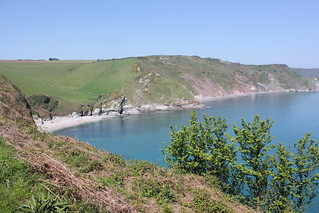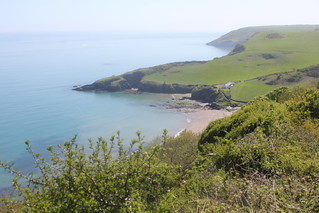Synopsis: Cycled to Topsham for this walk. Walked to Woodbury Common via Woodbury. Includes Woodbury Fort, Bystock Nature Reserve and Point of View chapel. Train Lympstone to Topsham.
Plan ‘B’. The reason being, Plan ‘A’ required bus travel, and this being a bank holiday, that was strictly limited. So, the night before, I sat down and quickly plotted this walk, based upon bicycle and train transport. To kick-start the day, all that was required was a 3 mile cycle ride to the railway station at Topsham. I parked my bicycle in the station cycle rack and sat on a bench to get into my walking boots. I slung my cycle shoes in the hedge and was then on my way.
I wished to get into the country reasonably quickly, so I selected what I think is the shortest route avoiding the main road. It involved picking up the Exe Estuary Cycle Trail which crosses the River Clyst on the relatively new walk/cycle bridge, adjacent to the railway bridge, built to improve the trail route. The bridge could be glimpsed through the trees as I looked back.
The village of Ebford is on the busy main road, which I had to cross, but once away from the enormous volume of traffic on the road today, headed for Exmouth beach, the village centre was actually quite tranquil and picturesque. Ebford Manor (Listed Grade II*) was just visible behind the houses at the village centre.
I was soon leaving the village and walking along country lanes. The sun was strong and the air in the lanes very warm and humid. Part of this route I had walked before, but today I wanted to detour, taking another course, which involved me crossing another busy road, that to Woodbury. Across the road, I picked up a rutted track that was first perpendicular to the main road, then curving right in the direction of Woodbury. This was really easy level track walking through glorious countryside with little evidence of the busy road nearby.
My navigation was a little bewildering on leaving Bond’s Lane. I picked up a track which seemed to peter out near an entrance to what I think was a farm. I could make out the fact that the intended continuation from this point was in fact a green lane, still visible, but completely overgrown and impassable. I backtracked to the lane feeling rather glum. There was a public footpath sign by the corner of the lane, but without a map, it’s precise direction was unknown. Its direction seemed roughly right, and there being no other reasonable alternative, I decided to give it a go.
I was glad I did, as it was, almost precisely, my intended course. It was obvious to me that the green lane has now been abandoned, and that walkers are now directed along this public footpath that runs adjacent to it, following field boundaries. This was fine as a walker, but it wouldn’t be quite so clever if on a bicycle, and for that reason, it’s rather unfortunate that the green lane has been deprecated. To transport a bike along this stretch today, would require humping it over two stiles, one at each end.

Part way along this path the steeple of Woodbury parish church came into view, slightly sunken below the hedge line in front of me. I had chosen to bypass the village centre and make urgent tracks on towards Woodbury Common. I was getting hungry. The lane ahead of me rose gently and soon Woodbury Castle (Scheduled Ancient Monument) [Historic England List] came into view, and I decided to make that my lunch stop. There are trees at the fort, and this would provide some welcome respite from the intense rays of the sun. I reached the fort just before 14:00.

I’ve always liked Woodbury Castle. It’s impressive in scale and location. And, on a sunny day like today, the sun streams upon it through the brightly coloured leaves of the trees all around. I confess, as kids, we scrambled all over it, as countless others must have done, and still do, with scant veneration for the castle’s time-honoured history. Today, my visits are more contemplative, if not quite so much fun.
After my picnic lunch, sat on a log at the centre of the castle, I took a little time out to walk part of the circumference of the embankment. The ancient builders, without doubt, laid a significant stake on this plot of land. I walked on out to the nearby viewpoint and looked upon the Exe estuary and Exeter. I expected Exeter Cathedral to be the prominent architectural feature my eye would fall upon, but of course it wasn’t, it was the new IKEA store, in its blue and yellow, that forms the most recognisable object in the landscape.
My intention today was to only clip part of Woodbury Common which warrants more time than I shall allow on this walk. I crossed the road and headed for a gap in trees near the horizon. I then diverted onto a track that passes between extensive quarry workings. A few trees provided a little shade. I had to make a minor navigational correction at this point (day-dreaming once again).

A little way down a lane I had picked up was a welcome sign indicating an entrance point to Bystock Nature Reserve [Devon Wildlife Trust]. This is a favourite place of mine, a little oasis, probably much neglected. I knew from previous visits there was seemingly another entrance path to the reserve, but I had not explored it. Although not my original intention, this was too good to pass-up, so I decided to explore.

I followed what was obviously the source of the ‘Ponds’, which was merely a miniscule trickle of water running off the common. Walking a little further along the path through trees and I had reached a point I recognised as being the far end of the reserve. I picked up the path that circumnavigates the plot and followed this until I reached a point where an alternative path branched off right and decided to explore this, as it would, if possible to follow, get me back on course.

It became obvious that I wasn’t on a formally recognised path, but nevertheless one that a few people do use. I reached a five-bar gate which was padlocked, so I had to climb this. Continuing on, I eventually reached a barrier at the point where the path intersected a lane. Yet more evidence of a recognised but discouraged approach to the reserve. I was now very close to picking up my planned route, which was along St John’s Road, which is a relatively quiet lane running off of the common towards Exmouth, much preferred by me to the other much busier routes.

Walking St John’s Road also provided me with the added advantage of allowing me, once again, to pay my due respects to my great-grandmother, Sarah Elizabeth England (née Rockett), buried in the cemetery at the Church of St John in the Wilderness (Listed Grade II*) [Historic England List]. Sarah, who went under the name Elizabeth, took some hunting down through ancestral research to find, and is therefore a momentous treasure to me.
I continued on down St John’s Road, past South Lodge (of Bystock Court (Listed Grade II) [Historic England List]), having passed Higher Lodge earlier on on this road), and then picked up a busy road through an urban landscape at the back of Exmouth. A little road/track/path waking of a somewhat mundane nature was now required to get me to the point where a lane breaks off in the direction of Lympstone village.

It was 17:00 by the time I reached my intended lane. Of the two destinations initially of interest, only one was now possible, as the other, A La Ronde [National Trust], would unfortunately be closed. This left me the delightful The Point in View (Listed Grade I) [Historic England List]. This is the chapel created by the Misses Parminter cousins who built nearby A La Ronde. Miss Jane is buried here. It’s lovely.
I walked on, and, as expected, A La Ronde was closed. I stopped briefly by the gate to glance in at the building. If only I’d got up earlier! So, I passed by, and wandered down the lane to the main road. Subsequent to my walk, I happened to note that the rather uninspiring garage on the corner is a listed building. So, yes, Haldon Motors (formerly Pearson’s Garage) (Listed Grade II) [Historic England List], is of greater interest than one might at first think. It is thought that it was probably originally a lodge to A La Ronde (GSV).
Once I’d crossed the busy main road, no easy matter, it was simply a matter of following lanes, tracks and footpaths down the hillside into Lympstone. There were some pleasant views out over fields down to the Exe Estuary to be had as I went. I heard a train travelling in the Exmouth direction, which I knew meant that I had about 10 minutes before it returned in the direction of Exeter. I arrived at Lympstone railway station with a minute to spare. The train was extremely packed, but I wasn’t concerned, as mine’s was only a short hop back to Topsham.
I collected my bike, swapped my hiking boots for cycling shoes, and was soon cycling home. It was lovely to find such highly enjoyable hiking right on my doorstep. It proved to be an excellent plan ‘B’ after all.
UK weather: May 2018 hottest since records began in UK – BBC News 02/06/2018. I can believe it!
Cycle/Walk Statistics:
Total Distance (Combined Cycle/Walk): 31.6 km / 19.6 miles -:- (Walk): 22.2 km / 13.8 miles
Elapsed Time (Combined Cycle/Walk): 7hrs 50min -:- (Walk): 7hrs 04min
Moving Time (Walk): 6hrs 34min
Stopped Time (Walk): 0hr 30min
Total Ascent (Combined Cycle/Walk): 362 metres
Maximum Elevation (Combined Cycle/Walk): 221 metres
Buses: (none)
Train: Lympstone to Topsham – off-peak day single with Devon & Cornwall Railcard: £1.90
…… Normal ticket price, without railcard discount (33%) would have been: £2.90
Train return: 18:05 – 18.13 (8mins) – no changes






















































